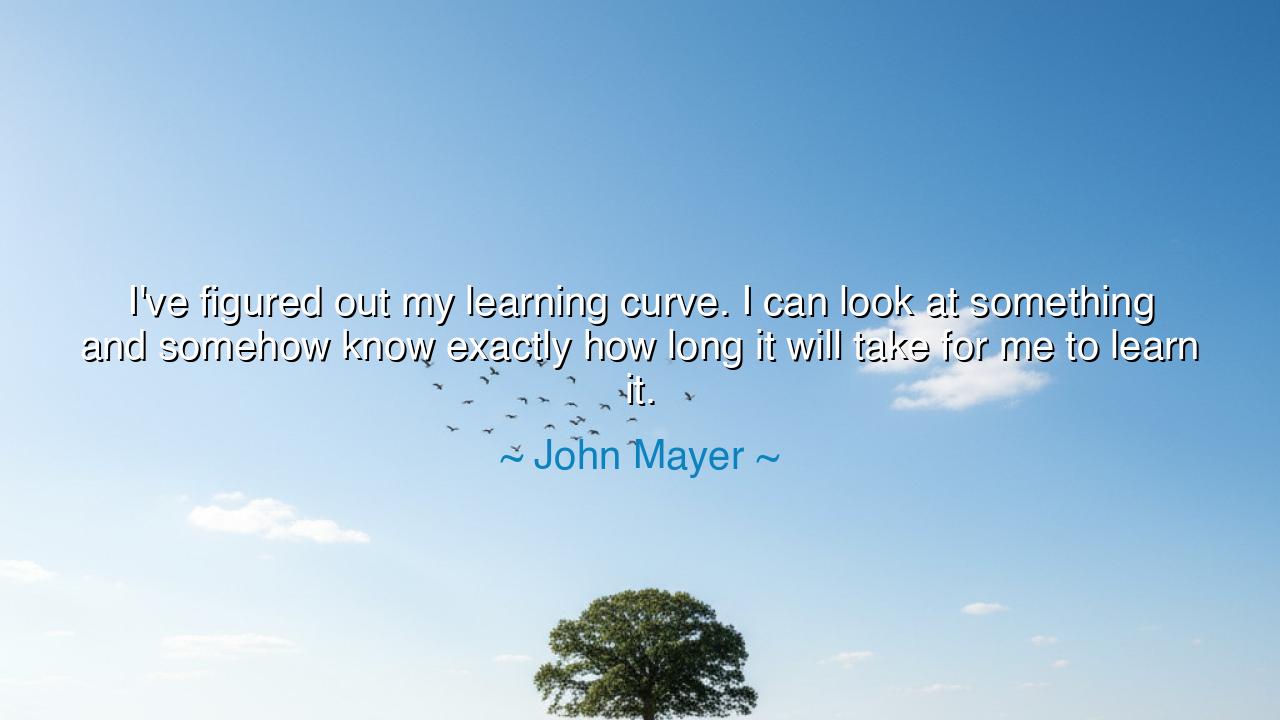
I've figured out my learning curve. I can look at something and
I've figured out my learning curve. I can look at something and somehow know exactly how long it will take for me to learn it.






When John Mayer said, “I’ve figured out my learning curve. I can look at something and somehow know exactly how long it will take for me to learn it,” he was speaking as one who had come to understand the rhythm of his own mind — the sacred measure of growth that separates mastery from confusion. His words, though spoken by a musician, ring true for all who strive toward excellence. For they reveal a truth that the ancients themselves cherished: that wisdom begins when a person knows not only what to learn, but how they learn. To recognize one’s learning curve is to possess the map of self-mastery — a gift rarer than talent itself.
In ancient philosophy, to “know thyself” was considered the first commandment of wisdom. Socrates, the great questioner, built his entire teaching upon this single idea. He believed that ignorance of the self was the root of all folly, while self-knowledge was the doorway to clarity and freedom. Mayer’s reflection belongs to this same lineage. By understanding his learning curve, he acknowledges the structure of his own mind — its tempo, its patience, its way of digesting skill and transforming effort into understanding. It is the mark of maturity to know not merely that one can learn, but how long it takes, and what kind of struggle that learning demands.
There is a kind of quiet power in this awareness. It gives one the ability to approach challenges without fear and to labor without despair. Many fail not because they lack ability, but because they misjudge the time and persistence that true mastery requires. They demand fruit before the seed has taken root. But the one who knows his learning curve does not lose heart when the path grows steep. He endures, because he has seen this mountain before — he knows the length of the climb and the strength of his own stride. Such knowledge turns frustration into focus and impatience into purpose.
Consider the story of Leonardo da Vinci, whose genius was not in his speed, but in his deep understanding of process. He could spend years on a single work, not out of hesitation, but because he understood the rhythm of his own discovery. His notebooks show endless experiments, sketches, and reflections — not the impatience of one seeking quick results, but the confidence of one who knows how long the mind must steep before brilliance emerges. Like Mayer, Leonardo had “figured out his learning curve.” He was not a servant to time, but a partner to it.
Mayer’s quote also reveals a deeper truth about learning as a living art. To know one’s learning curve is to accept that knowledge is not conquered but cultivated. Learning is not a ladder to be climbed, but a river to be crossed with rhythm and grace. Each person has their own current — some swift, some slow, all flowing toward understanding. Those who rush are swept away by frustration; those who move with awareness reach the far shore in peace. Mayer’s insight reminds us that true learning is not measured by speed, but by alignment with one’s nature — by the harmony between effort and patience.
This awareness of pace also requires humility. To admit that learning takes time is to bow before the mystery of growth. The proud mind demands mastery at once; the wise mind honors the slow unfolding of skill. The seed does not bloom because we shout at it — it blooms because we nurture it in rhythm with the seasons. So too, the learner must be gentle with himself. Mayer’s words show a man who has made peace with his limitations and turned them into strengths. He knows that the journey of mastery is not about rushing to the end, but about walking each step with awareness.
The lesson is this: learn yourself before you learn the world. Know how your mind grows, how your heart endures, and how your focus thrives. Once you understand your rhythm, every act of learning becomes an act of harmony. You will no longer compare your pace to others or despair at delay. Instead, you will walk your own path with confidence — not hurried, not idle, but steady.
So, let this truth settle in your spirit: to know your learning curve is to know your destiny’s rhythm. When you understand how long it takes for your mind to bloom, you no longer fear the seasons of delay or the storms of struggle. You learn to trust the process, to persist in peace, and to rise in your own time. For wisdom, like music, is not found in rushing through the notes — it is found in mastering the pauses between them.






AAdministratorAdministrator
Welcome, honored guests. Please leave a comment, we will respond soon